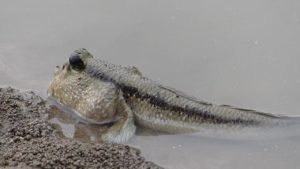
But then again, as you might guess, I know of one that can. I first met this odd and exceptional member of the fish fraternity in Southeast Asia; Malaysia to be precise. It was in this beautiful tropical country, bounded by the Straits of Malacca to the west and the South China Sea to the east, that I first really became familiar with the ocean’s tidal behavior. Subsequently I also grew acquainted with the rhythmic parade of animals which marched to the tune of the rising and ebbing tides.
Each day, along myriad coastlines throughout the world, the levels of the water of the world’s oceans rise and fall in concert with the gravitational effects of the moon and, to a lesser extent, the sun. Generally speaking there are two high tides and two low tides during an earth day. I found, as a newcomer to the world of tidal influences, that the extension of the coastline during low tides opened up a whole new arena for experiencing the life forms of the sea. In many areas, the retreating sea left behind tidal pools. While exploring these little ponds of retained seawater, one could never predict what might have been imprisoned as the ocean withdrew. It could be a lovely eagle ray trapped by the ebbing tide, an octopus flowing under a protective coral ledge, prickly sea urchins, a cushion starfish looking odd with its absence of arms, an incautious parrotfish; all these were possibilities. In other areas the receding tide might leave only vast expanses of mud flats. These mucky wildernesses had their own assemblage of creatures and it was here that I learned that a fish really can climb a tree.
Meet the mudskipper. Along the west coast of peninsular Malaysia lived several species of mudskippers. Upon first seeing one, I was struck by the bulging appearance of its huge, frog-like eyes. One genus of Malaysian mudskipper, Periophthalmus, is named after these huge, protruding, far-seeing eyes. I should have recognized it as a member of the goby family; they all seem to have really big eyes. But, after all, this was my first encounter with a strange, big-eyed fish clambering about on land and willfully forsaking all relationship with the sea.
Mudskippers are not large fish. Depending upon the species, their size 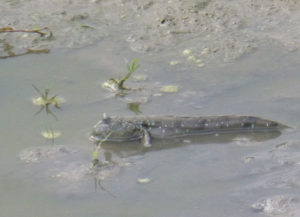 varies from two to nine inches in total length. Their hues tend to be a bland, a mud-colored beige or chocolate which serves to camouflage them upon the tidal flats they inhabit. During the breeding season the colors of males become more vibrant with the body being marked by dark, black, bars the sides and dorsal fins spotted with turquoise or shaded in red. They are quite attractive at this stage.
varies from two to nine inches in total length. Their hues tend to be a bland, a mud-colored beige or chocolate which serves to camouflage them upon the tidal flats they inhabit. During the breeding season the colors of males become more vibrant with the body being marked by dark, black, bars the sides and dorsal fins spotted with turquoise or shaded in red. They are quite attractive at this stage.
Mudskippers move about over the tidal mudflats with an odd lurching forward upon their pectoral (front) fins. This type of locomotion has been called, in a descriptively accurate way, as crutching. In their mode of locomotion they reminded me of little miniature walruses. Among mudskippers, the supporting structures of the pectoral fins project out from the body and move in a manner analogous to a shoulder joint. These fins also have a wrist-like joint at their distal ends. As a result, the fins bend outward to form a contact surface with the mud much like a primitive foot. Think of dragging yourself across the floor using only your straightened arms. If you did this by moving both arms simultaneously (no easy task) you would be crutching along like a mudskipper.
I found watching mudskippers to be both an inexpensive and an absorbing way to spend a day. Most often during my visits to the mudflats exposed by the receding tide, they were populated by dozens of lively mudskippers.  Some were active predators and could be seen making a sudden chomp upon an unsuspecting soldier crab. These little crustaceans I found fascinating in their own right. They typically occurred in platoons numbering in the hundreds and they roamed the flats feeding upon the detritus in the mud. When I approached them, they would retreat en masse toward the water. If I approached more rapidly, they would halt their retreat and begin to dig directly beneath themselves. The result was a disappearing act in which they all suddenly vanished simultaneously into the mud as though abruptly teleported to another world.
Some were active predators and could be seen making a sudden chomp upon an unsuspecting soldier crab. These little crustaceans I found fascinating in their own right. They typically occurred in platoons numbering in the hundreds and they roamed the flats feeding upon the detritus in the mud. When I approached them, they would retreat en masse toward the water. If I approached more rapidly, they would halt their retreat and begin to dig directly beneath themselves. The result was a disappearing act in which they all suddenly vanished simultaneously into the mud as though abruptly teleported to another world.
Other mudskippers could be seen propelling their torpedo-shaped bodies slowly across the muck, their heads moving back and forth like a miniature grazing cow. These were feeding on the algae which grew upon the muddy surface of the tidal flats. Occasionally I would see a pair of males locked jaw to jaw in a territorial dispute. Alternately tugging and pushing they vied mightily for possession of the mutually desired piece of property. At other times I would see a male do a tail-stand or flip himself violently across the mud in an attempt to draw the attention of an admiring female. All in all it was quite an entertaining tableau that was spread before me on the exposed mud.
As noted, all this foraging, territorial, and mating behavior was often carried out far from the water’s edge. That in itself was notably unusual for a fish. After all they do have gills and gills are generally meant for use in the water. Mudskippers have evolved several ways to circumvent the issue of using gills while out of the water. First, they can carry out cutaneous respiration through their skin. Similar to some amphibians, oxygen and carbon dioxide simply diffuse between the skin and air. This demands that the skin be moist so the mudskippers periodically doused themselves in a tidal pool or rolled in the wet mud. Another of their adaptive tricks was taking a huge gulp of air and holding that in their gill chambers while out of the water. As an additional safeguard, they are also inordinately tolerant of low oxygen levels in their body tissues.
In many areas, the transition from ocean/mudflat to drier ground was marked by broad swaths of mangrove trees. It never ceased to amaze me to 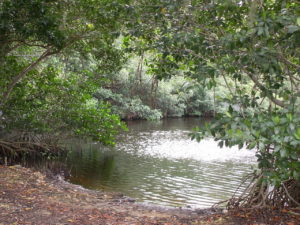 see a tree growing with its feet periodically standing in salt water. We tend to think of salt as anathema to plants and yet this incredible salt tolerance is a hallmark of these plants. Mangrove forests are extremely important because many marine animals use their intertwining, stilted roots as nurseries for their young. Mangroves provide ideal breeding grounds for many of the world’s fish, shrimp, crabs, and other shellfish. Khun Pisit, a Thai mangrove preservationist had this cleverly accurate analogy to offer regarding mangroves.
see a tree growing with its feet periodically standing in salt water. We tend to think of salt as anathema to plants and yet this incredible salt tolerance is a hallmark of these plants. Mangrove forests are extremely important because many marine animals use their intertwining, stilted roots as nurseries for their young. Mangroves provide ideal breeding grounds for many of the world’s fish, shrimp, crabs, and other shellfish. Khun Pisit, a Thai mangrove preservationist had this cleverly accurate analogy to offer regarding mangroves.
“Mangroves are like the kindergarten, seagrasses are the secondary schools, and coral reefs are the high schools and colleges for fishes! And, once the fishes graduate from university, they return to kindergarten to spawn.”
Imagine my surprise when I first visited the mudskippers of Malaysia and found them not just out of the water but occasionally perched up in the roots of the mangroves. Mudskippers use this aerial world as another place to find food. 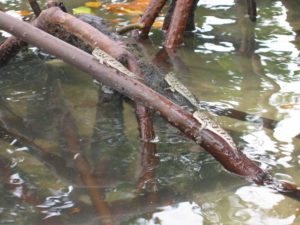 Crabs, insects, and algae may all be found upon the mangrove roots and can provide nourishment for the fish. Quite logical that it would be advantageous for them to climb up there, but I must say it was still a there were no land vertebrates. How we might ask did vertebrate animals, common in the sea for millennia, come to inhabit the dry lands of the world?
Crabs, insects, and algae may all be found upon the mangrove roots and can provide nourishment for the fish. Quite logical that it would be advantageous for them to climb up there, but I must say it was still a there were no land vertebrates. How we might ask did vertebrate animals, common in the sea for millennia, come to inhabit the dry lands of the world?
It was up to the likes of Eusthenopteron, Panderichthys, and Tiktaalik to begin the monumental advancement of back-boned animals from water to land. Such fishes possessed not only gills but a lung capable of retrieving atmospheric oxygen. Additionally, their fins were leg-like. This would have enabled them to creep up onto mud flats just as Periophthalmus does today. In being so-constructed, we might say that these ancient fishes were thus preadapted to tentatively, gradually enter the terrestrial world. This new world was much to their evolutionary advantage. It was a land devoid of large predators, rich with potential food sources, and totally lacking in other vertebrate species which might compete for prey.
As I stared in rapt attention at the little mudskippers, I wondered if this 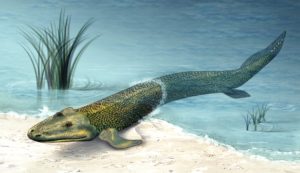 was a scene such as one might have encountered in those distant Devonian times. Here were fishes leaving the sea to explore a realm of new opportunity. We may presume that the fishes which made this giant leap from sea to land were not mental giants; they did not embark upon a premeditated course. They were simply driven onward by the instinctive search for space, food, and predator avoidance. But in them we behold the ancestors whose descendants would radiate into the thousands of vertebrate species which came to populate every ecosystem upon the earth.
was a scene such as one might have encountered in those distant Devonian times. Here were fishes leaving the sea to explore a realm of new opportunity. We may presume that the fishes which made this giant leap from sea to land were not mental giants; they did not embark upon a premeditated course. They were simply driven onward by the instinctive search for space, food, and predator avoidance. But in them we behold the ancestors whose descendants would radiate into the thousands of vertebrate species which came to populate every ecosystem upon the earth.
So it was that the pint-sized mudskipper, doing nothing more than go about its daily business, allowed me a glimpse into earth’s far distant history, a peak into our own deep-time ancestry. Genetic variability, lengths of time virtually impossible for us to imagine, the incredible propensity of the Universe to evolve toward ever-increasing diversity, complexity, and beauty were all revealed in the contemplation of this single, quirky, diminutive member of the animal kingdom.
Many thanks little fish. Perhaps I am able to see a bit farther now.
Photos courtesy commons.wikimedia.org
giant mudskipper by Bernard DuPont at
mudskipper male & group by Vmenkov
mangrove trees by Moni3
mangrove roots by Jonathan Wilkins
mudskippers on mangrove roots by Thomas Hoven
Tiktaalik by Zina Deretsky NSF
vertebrate tree of life by Ernst Haeckel
